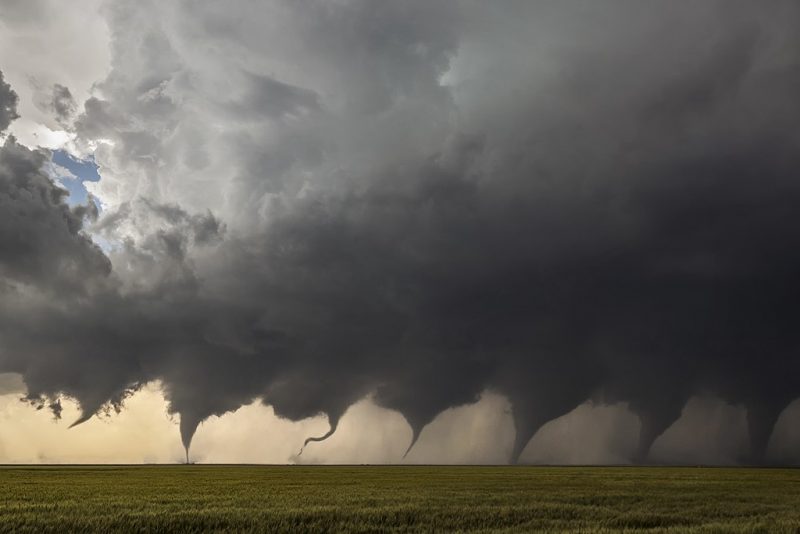The central United States has once again borne the brunt of nature’s fury as a series of dangerous weather events wreaked havoc across multiple states. From violent tornadoes and destructive thunderstorms to torrential rains and flash flooding, the region has experienced widespread damage, leaving communities in distress and emergency responders working tirelessly to assist those affected. The severe weather, which struck with little warning in some areas, has underscored the vulnerability of the region to extreme meteorological events and raised concerns about the increasing frequency and intensity of such disasters in a changing climate.
Tornadoes Leave a Trail of Destruction
Among the most devastating elements of this recent weather outbreak were the tornadoes that tore through several states, including Oklahoma, Kansas, and Missouri. Eyewitnesses described terrifying scenes as funnel clouds descended from darkened skies, reducing homes to rubble, uprooting trees, and flipping vehicles. In one small town in Oklahoma, an EF-3 tornado with winds exceeding 140 mph carved a path of destruction nearly a mile wide, leaving entire neighborhoods unrecognizable.
Local authorities reported multiple injuries, and tragically, at least three fatalities were confirmed as rescue teams sifted through debris in search of survivors. Emergency shelters were quickly set up in schools and community centers, offering temporary refuge for displaced families. The American Red Cross and other relief organizations mobilized to provide food, water, and medical assistance to those in need.
Powerful Thunderstorms and Hail Add to the Chaos
Accompanying the tornadoes were severe thunderstorms that brought damaging winds and large hail. In parts of Kansas, hailstones the size of golf balls shattered windows, dented cars, and destroyed crops, dealing a significant blow to local farmers already struggling with unpredictable growing conditions. Wind gusts exceeding 70 mph knocked down power lines, leaving tens of thousands without electricity for hours, and in some cases, days.
Utility companies worked around the clock to restore power, but the sheer scale of the damage made progress slow. Fallen trees blocked roads, hindering emergency response efforts and forcing some residents to wait anxiously for help. The National Weather Service issued repeated warnings, urging people to stay indoors and avoid unnecessary travel as the storms continued to move eastward.
Flash Flooding Submerges Communities
In addition to wind and hail, relentless rainfall led to dangerous flash flooding in low-lying areas. Rivers and creeks swelled beyond their banks, inundating streets and homes with murky, fast-moving water. In Missouri, several neighborhoods were completely cut off as floodwaters submerged roads, making rescue operations difficult.
One harrowing incident involved a family trapped in their vehicle as rising waters swept it off the road. Fortunately, first responders arrived in time to pull them to safety, but the close call served as a stark reminder of the deadly risks posed by flash floods. Meteorologists warned that even after the rain stopped, the flood threat would persist as water continued to flow downstream.
Climate Change and the Rising Threat of Extreme Weather
Scientists have long warned that climate change is contributing to more frequent and intense weather events, and this latest outbreak adds to a growing body of evidence. Warmer temperatures increase atmospheric moisture, fueling stronger storms, while shifting weather patterns create conditions ripe for tornado formation. The central U.S., often referred to as “Tornado Alley,” is particularly vulnerable, but recent trends suggest that these dangers may be spreading to other regions as well.
Emergency management officials emphasize the importance of preparedness, urging residents to have emergency kits, evacuation plans, and multiple ways to receive weather alerts. Advances in forecasting technology have improved warning times, but when storms strike with little notice, every second counts.
Community Resilience in the Face of Disaster
Despite the devastation, stories of resilience and solidarity have emerged from the affected areas. Neighbors helped neighbors clear debris, volunteers distributed supplies, and local businesses donated resources to support recovery efforts. Social media played a crucial role in connecting displaced families with assistance and spreading critical information.
State and federal agencies are now assessing the damage to determine eligibility for disaster relief funding. Rebuilding will take months, if not years, but the determination of these communities remains unshaken.
Conclusion
The recent severe weather outbreak in the central U.S. serves as a sobering reminder of nature’s power and the urgent need for climate adaptation strategies. While scientists work to better understand these phenomena, individuals and governments must prioritize preparedness and infrastructure improvements to mitigate future risks. For now, the affected regions focus on healing—one day at a time—as they pick up the pieces and rebuild their lives in the wake of destruction.




